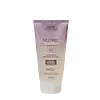What's inside
What's inside
 Key Ingredients
Key Ingredients

 Benefits
Benefits

 Concerns
Concerns

 Ingredients Side-by-side
Ingredients Side-by-side

Water
Skin ConditioningNiacinamide
SmoothingXanthan Gum
EmulsifyingButylene Glycol
HumectantGlucose
HumectantSodium Hyaluronate
HumectantChondrus Crispus Extract
Skin ConditioningHydroxypropyltrimonium Hyaluronate
Hydrolyzed Hyaluronic Acid
HumectantSodium Acetylated Hyaluronate
HumectantHyaluronic Acid
HumectantSodium Hyaluronate Crosspolymer
HumectantHydrolyzed Sodium Hyaluronate
Skin ConditioningPotassium Hyaluronate
Skin Conditioning1,2-Hexanediol
Skin ConditioningCaprylyl Glycol
EmollientSodium Laureth Sulfate
CleansingCocamide DEA
EmulsifyingPhenoxyethanol
PreservativeParfum
MaskingCocamidopropyl Betaine
CleansingCitric Acid
BufferingSodium Hydroxide
BufferingWater, Niacinamide, Xanthan Gum, Butylene Glycol, Glucose, Sodium Hyaluronate, Chondrus Crispus Extract, Hydroxypropyltrimonium Hyaluronate, Hydrolyzed Hyaluronic Acid, Sodium Acetylated Hyaluronate, Hyaluronic Acid, Sodium Hyaluronate Crosspolymer, Hydrolyzed Sodium Hyaluronate, Potassium Hyaluronate, 1,2-Hexanediol, Caprylyl Glycol, Sodium Laureth Sulfate, Cocamide DEA, Phenoxyethanol, Parfum, Cocamidopropyl Betaine, Citric Acid, Sodium Hydroxide
Water
Skin ConditioningGlycerin
HumectantButylene Glycol
HumectantDecyl Glucoside
CleansingPentylene Glycol
Skin ConditioningDisodium Cocoyl Glutamate
CleansingPPG-5-Ceteth-20
EmulsifyingXanthan Gum
EmulsifyingCaprylyl Glycol
EmollientAcrylates Copolymer
Ethylhexylglycerin
Skin ConditioningTriethanolamine
BufferingParfum
MaskingBehenyl Alcohol
EmollientSucrose Stearate
EmollientDisodium EDTA
Isocetyl Alcohol
EmollientSucrose Tristearate
EmollientArginine
MaskingStearic Acid
CleansingSodium Lauryl Sulfate
CleansingTripeptide-3
Skin ConditioningWater, Glycerin, Butylene Glycol, Decyl Glucoside, Pentylene Glycol, Disodium Cocoyl Glutamate, PPG-5-Ceteth-20, Xanthan Gum, Caprylyl Glycol, Acrylates Copolymer, Ethylhexylglycerin, Triethanolamine, Parfum, Behenyl Alcohol, Sucrose Stearate, Disodium EDTA, Isocetyl Alcohol, Sucrose Tristearate, Arginine, Stearic Acid, Sodium Lauryl Sulfate, Tripeptide-3
Ingredients Explained
These ingredients are found in both products.
Ingredients higher up in an ingredient list are typically present in a larger amount.
Butylene Glycol (or BG) is used within cosmetic products for a few different reasons:
Overall, Butylene Glycol is a safe and well-rounded ingredient that works well with other ingredients.
Though this ingredient works well with most skin types, some people with sensitive skin may experience a reaction such as allergic rashes, closed comedones, or itchiness.
Learn more about Butylene GlycolCaprylyl Glycol is a humectant and emollient, meaning it attracts and preserves moisture.
It is a common ingredient in many products, especially those designed to hydrate skin. The primary benefits are retaining moisture, skin softening, and promoting a healthy skin barrier.
Though Caprylyl Glycol is an alcohol derived from fatty acids, it is not the kind that can dry out skin.
This ingredient is also used as a preservative to extend the life of products. It has slight antimicrobial properties.
Learn more about Caprylyl GlycolParfum is a catch-all term for an ingredient or more that is used to give a scent to products.
Also called "fragrance", this ingredient can be a blend of hundreds of chemicals or plant oils. This means every product with "fragrance" or "parfum" in the ingredients list is a different mixture.
For instance, Habanolide is a proprietary trade name for a specific aroma chemical. When used as a fragrance ingredient in cosmetics, most aroma chemicals fall under the broad labeling category of “FRAGRANCE” or “PARFUM” according to EU and US regulations.
The term 'parfum' or 'fragrance' is not regulated in many countries. In many cases, it is up to the brand to define this term.
For instance, many brands choose to label themselves as "fragrance-free" because they are not using synthetic fragrances. However, their products may still contain ingredients such as essential oils that are considered a fragrance by INCI standards.
One example is Calendula flower extract. Calendula is an essential oil that still imparts a scent or 'fragrance'.
Depending on the blend, the ingredients in the mixture can cause allergies and sensitivities on the skin. Some ingredients that are known EU allergens include linalool and citronellol.
Parfum can also be used to mask or cover an unpleasant scent.
The bottom line is: not all fragrances/parfum/ingredients are created equally. If you are worried about fragrances, we recommend taking a closer look at an ingredient. And of course, we always recommend speaking with a professional.
Learn more about ParfumWater. It's the most common cosmetic ingredient of all. You'll usually see it at the top of ingredient lists, meaning that it makes up the largest part of the product.
So why is it so popular? Water most often acts as a solvent - this means that it helps dissolve other ingredients into the formulation.
You'll also recognize water as that liquid we all need to stay alive. If you see this, drink a glass of water. Stay hydrated!
Learn more about WaterXanthan gum is used as a stabilizer and thickener within cosmetic products. It helps give products a sticky, thick feeling - preventing them from being too runny.
On the technical side of things, xanthan gum is a polysaccharide - a combination consisting of multiple sugar molecules bonded together.
Xanthan gum is a pretty common and great ingredient. It is a natural, non-toxic, non-irritating ingredient that is also commonly used in food products.
Learn more about Xanthan Gum